Products You May Like
Get full access to Outside Learn, our online education hub featuring in-depth fitness, nutrition, and adventure courses and more than 2,000 instructional videos when you sign up for Outside+
Sign up for Outside+ today.
California has had a hell of a year, with a series of storms that have caused record flooding and forced thousands to evacuate their homes. Many have struggled, but part of the state has experienced a silver, or winter white, lining. In Yosemite National Park, one of America’s most popular natural treasuries, the storms have delivered epic winter conditions. This means that if you want to gaze up at El Capitan in solitude or like to cross-country ski, hike, snowshoe, and see raging waterfalls, you’re in luck.
Precipitation totals are more than 200 percent of the average for this time of year, so there are dramatic conditions throughout the park, with multiple feet of snow stacking up above 6,000 feet, and rivers and waterfalls at high flow levels in Yosemite Valley.
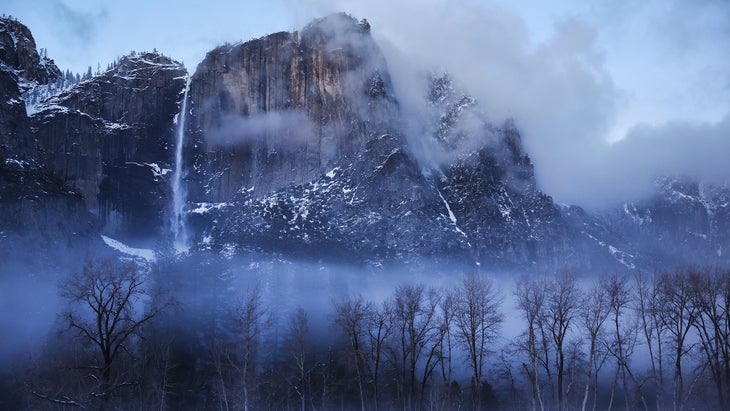
“Conditions are amazing right now,” says Cory Goehring, lead naturalist for the Yosemite Conservancy, the park’s nonprofit partner, which works to protect the park. Goehring lives in Mariposa, about 30 miles from Yosemite, and leads occasional snowshoe adventures in the park’s high country. “Yosemite has transformed into a winter wonderland. The park is so dynamic in elevation ranges, from 2,000 feet to 13,000 feet, [that] while the Valley saw a lot of rain, the rest of the park got a lot of snow. There are lots of excited people waxing up skis.”
The park is open and safe, though in any natural area you must be mindful of the surroundings. Rock slides are always a concern when moisture stacks up in and around the region, and a slide on Highway 140 leading to the park killed two people in late December. But the park roads are now clear, and there are currently no unusual trail or road closures. (Always check conditions here before traveling.)
“There were storms, there was a rockslide, but the Valley is great now,” says Ira Estin, a longtime hiking and photo-tour guide in Yosemite, who lives in Midpines, near Mariposa. “There’s plenty of snow if people want to snowshoe or cross-country ski. Conditions are great, and the waterfalls are going crazy.”
The worst of California’s storms is believed to be behind us, and the park is set for a brief dry period and milder conditions moving forward this winter, which means it is a great time to visit one of America’s most iconic national parks.
Here are four reasons to go to Yosemite right now.
Yosemite is way less crowded this time of year.
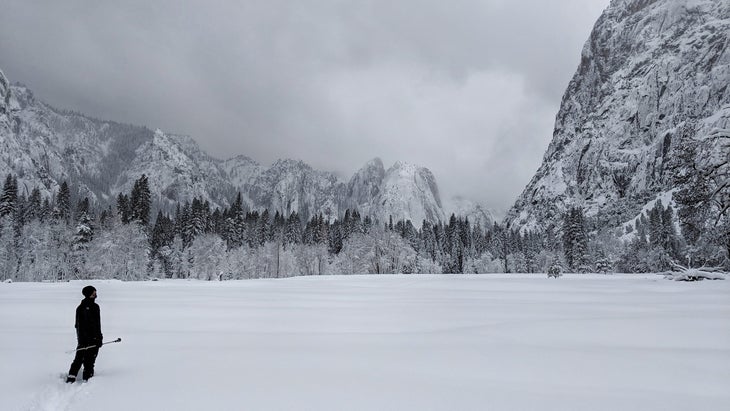
Winter is arguably the best time to visit Yosemite Valley, as a lack of crowds means you can actually find a parking space, and you can hike some of the valley’s signature trails without rubbing elbows with hundreds of strangers.
“We get four million visitors every year, but three million of those people come in June, July and August,” says Goehring. “It’s a time of solitude, even on the usually busy Valley floor.”
Use this downtime to hit some of the Valley’s most sought-after adventures that might otherwise be packed. Yosemite Falls Trail is one of the park’s most popular paths, and arguably the first hike that many visitors want to check off their dream lists. The tough 7.2-mile round trip starts at Camp 4 and gains 2,700 feet via a series of switchbacks through oaks until you hit a plateau that leads to the top of Yosemite Falls. If the upper portion of the trail is snowed in or you’re not up for the whole enchilada, you can turn around at the Columbia Rock overlook, for a three-mile round trip that takes you up switchbacks to a grand view across the Valley.
Goehring also recommends walking or riding the 12 miles of paved bike paths that wind through the Valley floor, which the Conservancy clears of snow. “In the summer, there are thousands of people on this path,” he says, “but in the winter, you feel like you have it all to yourself.” (Bike rentals are unavailable during winter inside the park, so bring your own.)
Check out our guide to the 13 best hikes in Yosemite for more inspiration.
The waterfalls are popping.

All of the rain has resulted in the emergence of almost a dozen seasonal, or “ephemeral,” waterfalls that typically only appear after snowmelt during the spring. Yosemite Falls and Bridalveil Falls have been more robust than ever lately, but you can also see unnamed streams tumbling over rock faces and rare, but named, waterfalls like Royal Arch Cascade, west of Half Dome.
“Some waterfalls will pop up for a day or two, and then the drainage dries up and they disappear, and some of them will run for six months,” Goehring says, adding that even if you miss the ephemeral falls, the winter temps create an ice spectacle on more consistent falls like Yosemite. “With cooler temps at night, you wake up in the morning and there will be ice sheets on Yosemite Falls the size of a football field. When they break off and hit the ground, it sounds like thunder throughout the Valley.”
Check out a live webcam of Yosemite Falls to get a sense for the volume of water pouring into the valley.
The snowshoeing is off the charts.
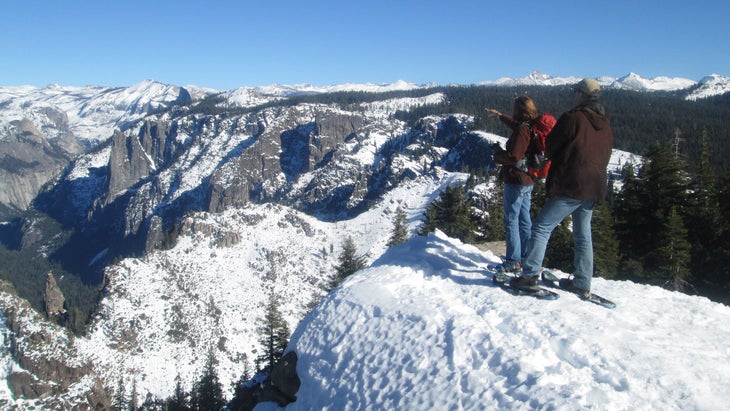
Strapping on a pair of snowshoes is the easiest way for visitors to experience the great snowy conditions in Yosemite’s high country. Start at Badger Pass Ski Area, a lift-served resort inside the park that also serves as the hub of a large network of marked winter trails for snowshoeing and cross-country skiing. National Park rangers lead free snowshoe walks from Badger Pass December through March. Badger Pass Nordic Center has snowshoe rentals ($28.50 a day) and Yosemite Mountaineering School offers guided snowshoe adventures as well (starting at $60). The Yosemite Conservancy offers guided trips, too ($105).
If you’re looking for an epic adventure, try the eight-mile round trip that starts at the Nordic Center and travels through meadows and a conifer forest to Dewey Point, where you can see El Capitan, Half Dome, Mount Hoffman, Mount Conness, and the Clark Range.
Yosemite is a nordic skier’s dream.
As good as the snowshoeing is right now, the cross-country skiing is even better. Skiers have options galore. There are 25 miles of groomed XC trails starting at Badger Pass, a number of backcountry huts you can ski to, and roads like Glacier Point, which is closed to traffic and managed for skiers from November to May. The Badger Pass Nordic Center has rentals ($31 a day) and Yosemite Mountaineering School offers guided trips from the center.
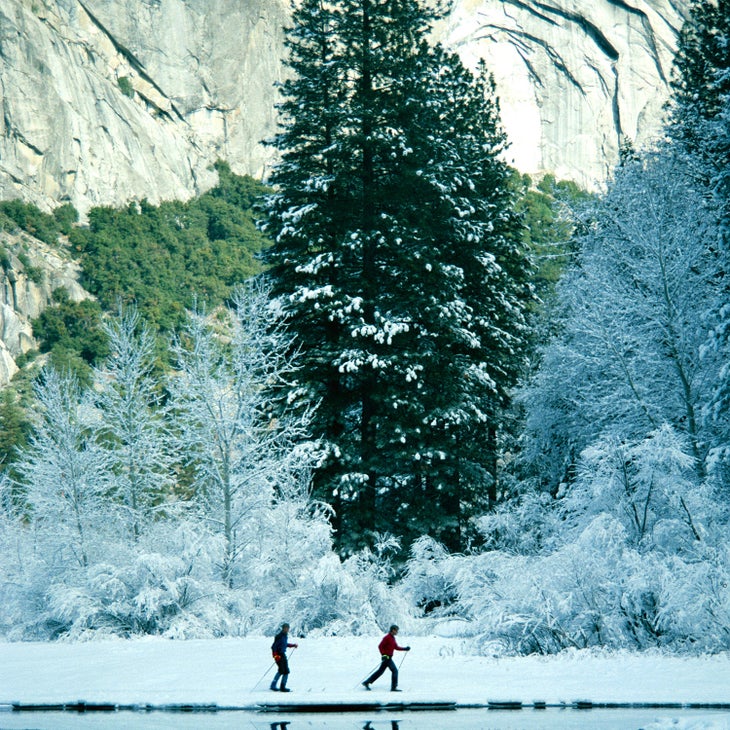
The signature XC ski adventure in Yosemite is to kick and glide your way along Glacier Point Road, which is groomed for skate skiers and classic skiers alike. It’s 10.5 miles to Glacier Point, which sits more than 3,000 feet above the Valley floor, offering a postcard-worthy view of Half Dome. A backcountry ski hut located at the point typically offers food and lodging, but is closed for renovations this winter. (Remember it for next time!) The view is still worth the effort, if you can handle a 21-mile out-and-back. Experienced skiers should expect it to take a full day, though even beginners can enjoy a shorter round trip on the groomed road; Summit Meadow, 2.8 miles up the road, makes for a great lunch spot and turnaround point.
Crane Flat, a high-elevation meadow and forest, 16 miles from Yosemite Valley, has ungroomed but marked winter trails for classic XC skiers. Gin Flat Loop, 6.25 miles in total, features a gradual three-mile climb up a trail and a fun three-mile descent down an ungroomed road. There’s also a dedicated Snowplay area where families can hop out of the car and sled or ride toboggans or inner tubes.
Winter Safety Considerations
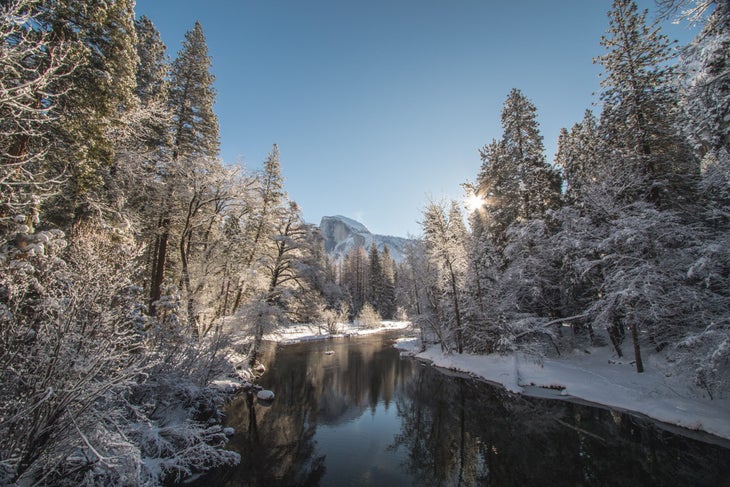
Expect temperatures ranging from the 20s to high 40s in winter in the Valley. As you gain elevation, those temperatures can drop, so be sure to pack winter layers.
Yosemite is a wild place, so there will always be dangers—such as avalanches on steep slopes and rock slides in canyons and near cliffs—to consider. Roads can close due to rock and debris slides. As well as using the Yosemite website, updated daily with current road closures, you can also call the park’s road status hotline (209-372-0200) and Yosemite’s Twitter account is a good source for up-to-date information. Highway 140 closed following a January 15 rock slide outside of the park’s boundary, between El Portal and Midpines, with partial opening (California Highway Patrol to escort motorists) on January 23 and one-way traffic beginning January 24.
All cars, even 4WD vehicles, entering the park are required to carry chains. You might not have to use them, but must have them in your vehicle. You can rent them from stores and gas stations in Mariposa, west of the park.
If you’re traveling in the backcountry on snowshoes or skis, be realistic about your abilities and any routes you plan on tackling. Tell someone where you’re going and when you’ll be back. Leaving a note on your car isn’t a bad idea, either. Carry a map and compass, prepare for weather changes with extra layers, and be ready to turn around. It’s easy to get lost even on familiar terrain when snow moves in. Even better, hire a guide.
Graham Averill lives in the Southern Appalachians, where in his opinion it doesn’t snow enough. One of his all-time favorite backcountry campsites is in Yosemite, on a ledge overlooking the Valley. He’s been writing for Outside for more than a decade.
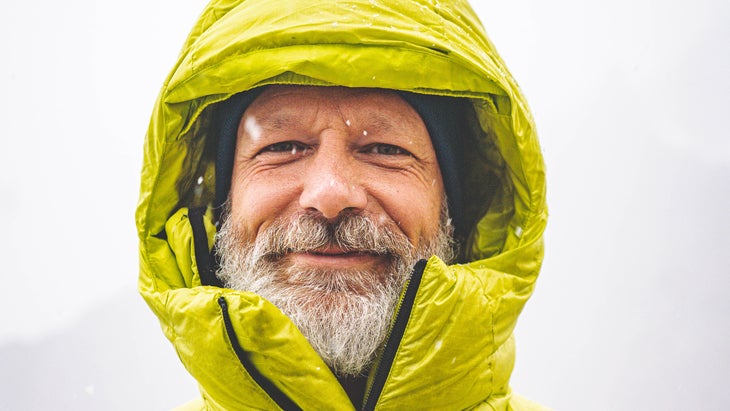
See:
